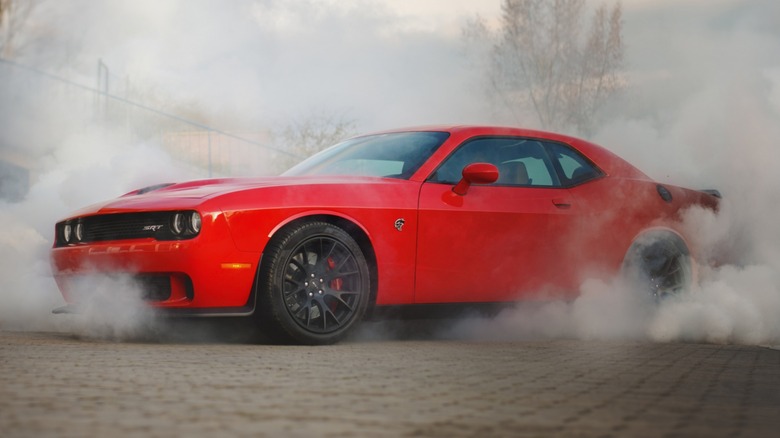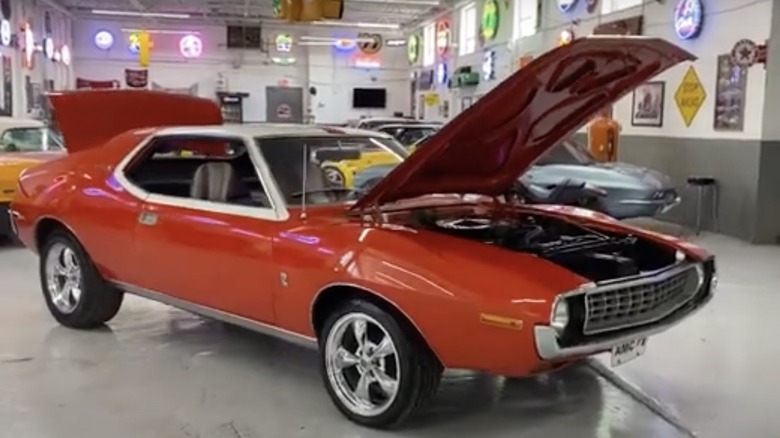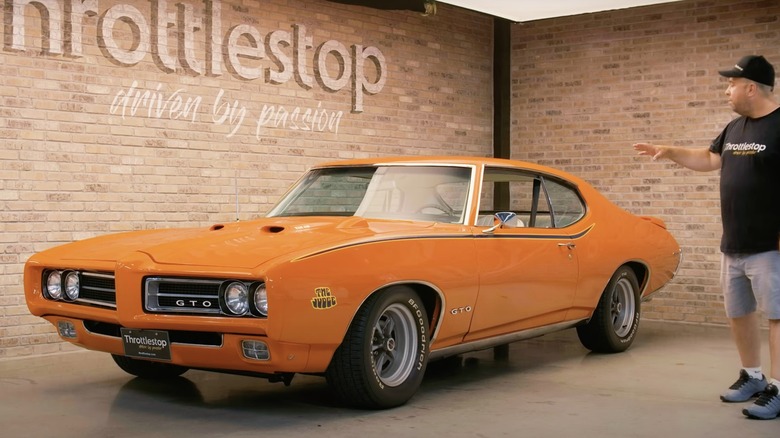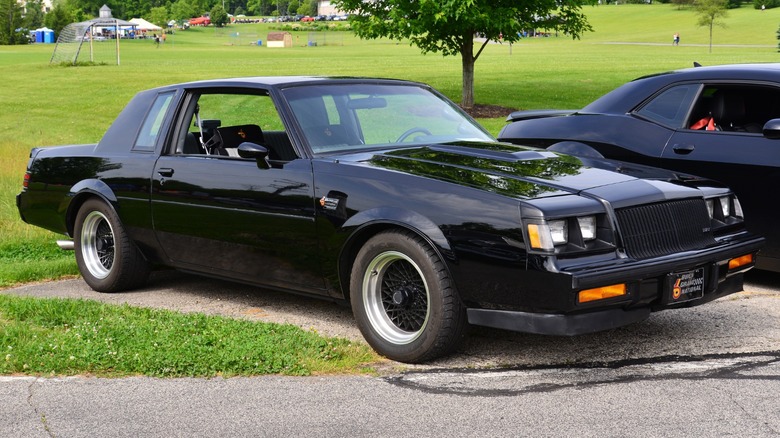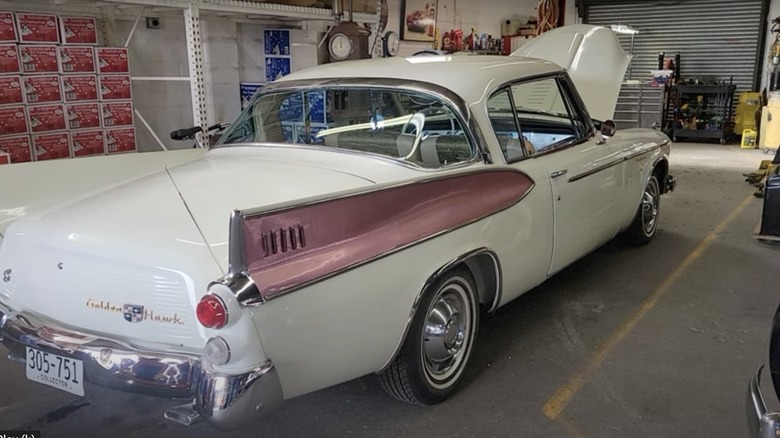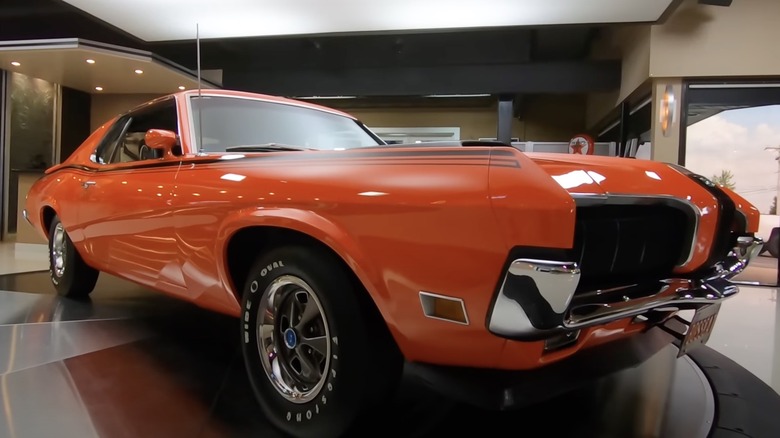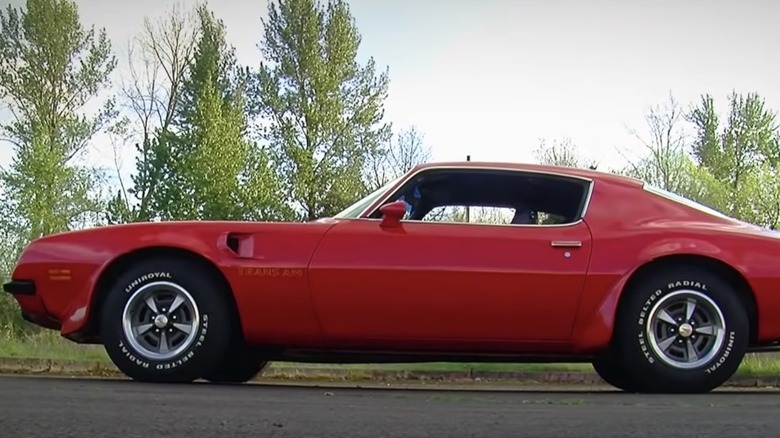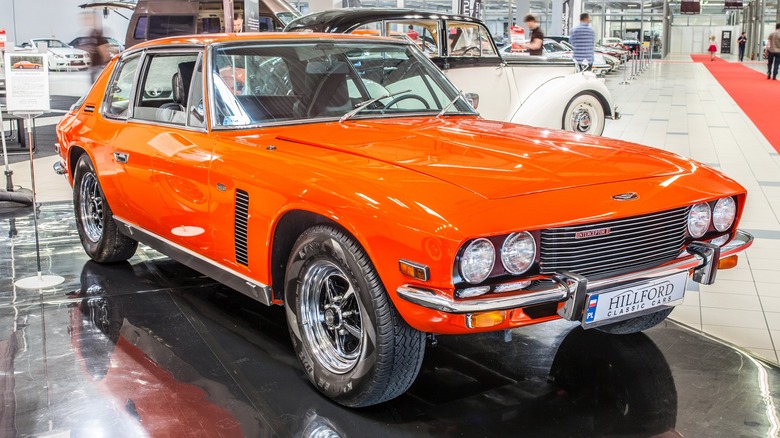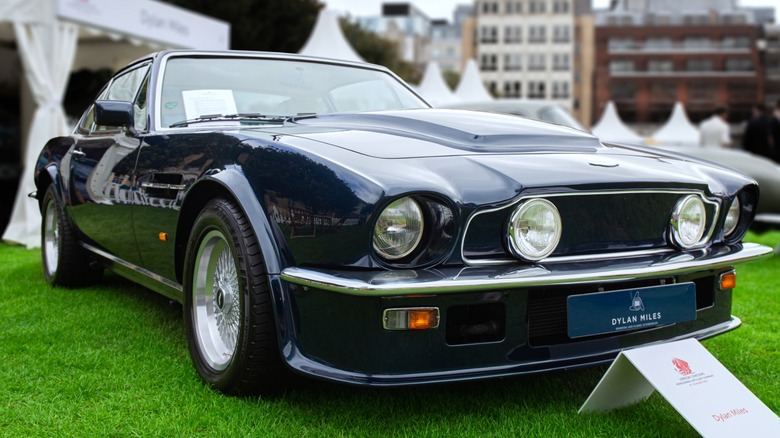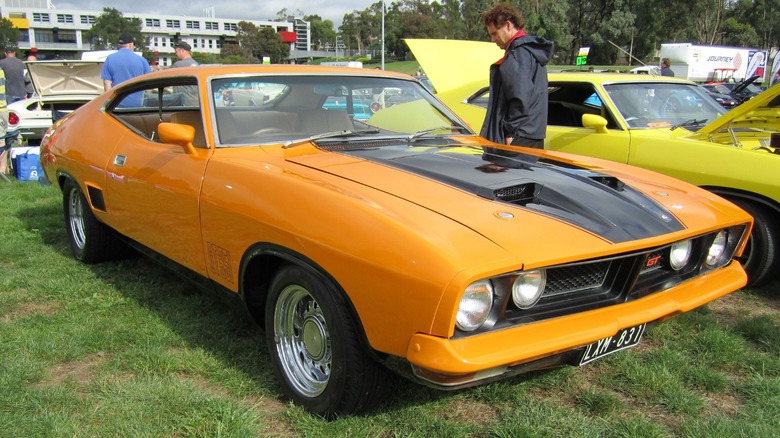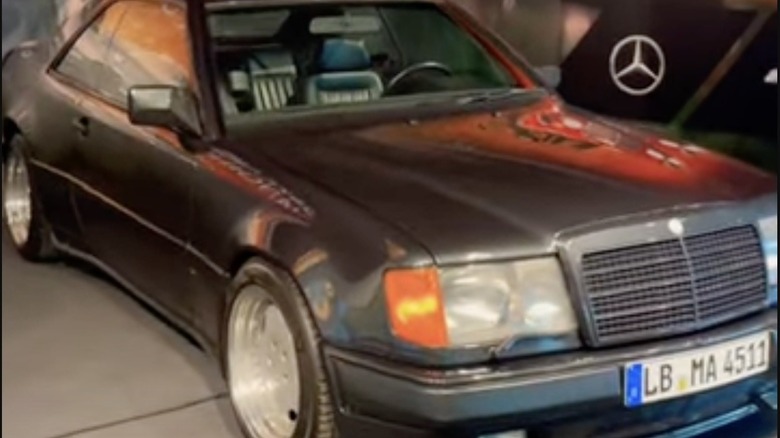10 Classic Muscle Cars We'd Gladly Choose As A Daily Driver Over A New Hellcat
Chrysler has created many excellent high-performing machines in recent years. Its reintroduction of the HEMI V8 in 2003 along with historic nameplates such as Charger and Challenger has led to a rebirth of the Chrysler that dominated the muscle car scene of the '60s and '70s. The HEMI is still around and Chrysler has been improving it ever since, leading to today's ludicrously-powerful Dodge Challenger SRT Hellcat, which has an output of a staggering 717 horsepower — 797 for the Hellcat Redeye model. Indeed, it's a fast car.
But with top speed limits around the country reaching 80 mph in the most generous jurisdictions, there are few places you can open up 700 horsepower and avoid tickets, jail time, or an impounded car. Hellcats are great at the track, but otherwise, it's mostly a waste of horsepower. For some, much more enjoyable would be to have a classic muscle car. These old cars may not be as fast, but they will turn heads everywhere you go. Sometimes the drive is what matters most.
Taking into consideration the definition of a muscle car, which is generally a front-engined, rear-wheel-drive car with two doors and four seats that is powered by a (usually) large V8, there are plenty of great classics to choose from. These classic muscle cars we'd gladly choose as a daily driver over a Hellcat.
1972 AMC Javelin Pierre Cardin
Always the underfunded underdog, AMC used tight budgets and clever innovation to come up with desirable cars that offered spry performance and, occasionally, stunning good looks. Its Javelin coupe is the quintessential American muscle car powered by a big AMC 401 V8 spinning the wheels through a 3-speed automatic. Power was only 255 horsepower, but with 345 ft-lb of torque, it can still be a tire squealer. Besides, this one has bona fide French fashion styling.
By 1972, AMC had to detune its engines due to new EPA emissions regulations. No longer able to sell cars on raw performance, management hired famous fashion designer Pierre Cardin to give its cars a special touch, not an unusual practice as other cars with Gucci, Cartier, Givenchy, and Bill Blass treatments were then found in dealerships. Cardin worked in France and, as one of the most prolific fashion designers of the 20th Century, held a large cache with the buying public in 1972.
The Javelin came with custom nylon upholstery incorporating a then-new stain-resistant silicone-based finish with minimalist stripes complemented by exclusive paint colors on the exterior. Despite being a gimmick, the look has aged well and remains fashionable and appropriate. AMC sold about 4,000 of these cars, and they are hard to find today. One sold at Mecum Auctions in 2022 with a closing bid of $104,000. This car won't win many street races today. However, it will generate conversations every time you fill it up.
1969 Pontiac GTO The Judge
Many say the muscle car era began when John DeLorean managed to get the GTO out to dealers in 1964, despite disapproval of the concept by management. The car proved to be a hit. But near the close of the '60s, Pontiac offered a very special edition GTO for sale, which was also a creation of DeLorean, The Judge.
The original concept for this car was that of a stripped-down high-performance model sold on the cheap, but plans morphed into a package that resulted in a mid-range special edition. The name came from a comedy sketch featuring Sammy David, Jr. on Rowan & Martin's Laugh-In that is said to be DeLorean's favorite at the time. With the package, buyers received a GTO with the Ram Air III 400 HO V8 engine with high compression, a high-lift cam, a 4-barrel carburetor, and a free-flowing exhaust. This was good for 366 horsepower and a healthy 445 ft-lbs of torque. The 1969 model year only came in Carousel Red, which looks more like an orange.
The Judge proved a popular option, making up 10% of all GTO sales in 1969. It continued for two more years and was offered in other colors after 1969. There is no mistaking a Judge. One of these classic Pontiacs would be a joy to drive every day, however, a rare convertible model sold at Mecum in 2023 for $1.1 million, making sightings in traffic highly unlikely.
1987 Buick GNX
Although many may say an American muscle car needs a V8, sometimes a V6 performs better than most V8s. A prime example of this is 1987's Buick GNX, a Regal-based car featuring an innovative turbocharged 3.8 V6 that was faster than most cars of its day. In the last year of Grand National production, Buick sent 547 copies to ASC/McLaren for tuning, resulting in the GNX, which stands for Grand National Experience.
The original Grand National was a good performer already. Even though engineers had to contend with emissions regulations and new technology, Buick added a turbo to the 3.8-liter V6 and managed 245 horsepower out of it — the 1987 Corvette was only rated at 240. ASC/McLaren added a larger Garrett turbocharger to the V6 and modified it to breathe a bit better. Then they reworked the engine management to get the power output up to 276 horsepower. That is good but the torque rating of 360 ft-lbs is what really gets the GNX off the line.
The rest of the car received the same smoked-out treatment of all-black paint and trim with a smoky gray interior featuring embroidered Grand National logos on the headrests and a prominent "Turbo 3.8 litre" badge on the dash. The GNX is a special car with a sinister look that would be a joy to drive daily. However, it is another one that can set you back more than any Hellcat, as one sold at Barrett-Jackson in 2021 for $275,000.
1958 Studebaker Golden Hawk
Most discussions of American muscle cars tend to be centered on cars from roughly 1964 to 1973. But if you consider the basic criteria for what makes a muscle car, the earlier 1958 Studebaker Golden Hawk checks all the boxes. Studebaker called it a "family-sized sports car," which is not inaccurate, but it also came with a bit of muscle under the hood in the form of an American V8.
The styling of the Golden Hawk makes it look very much like a thing of the 1950s, but, as it was designed by famed industrial designer Raymond Loewy, it remains beautiful today. The sculpted hood with its raised grille and the tail fins in the rear are its defining features. For 1958, buyers could choose a Silver Hawk with a 6-cylinder or step up to the Golden Hawk with either a 289 V8 making 210 horsepower or a supercharged 289 V8 making 275 horsepower and an impressive 333 ft-lbs of torque.
Golden Hawks were nice cars in their day. Sadly for Studebaker, the company would not see its own success as it folded by 1964. Driving one of these cars today is a rare treat sure to attract a crowd of inquisitive onlookers. Fortunately for modern buyers, the rarity of the cars is not reflected in prices. In 2017, a mint condition supercharged model sold on Bring a Trailer for $35,000, less than half the cost of a Hellcat.
1970 Mercury Cougar Eliminator
When talking muscle cars, the Ford Mustang takes a well-deserved top billing. However, with so many to choose from, sometimes it's nice to stray from the pack. A 1970 Mercury Cougar Eliminator is a great way to do that. Mercury was an upmarket brand from Ford, so the Cougar shared much of the chassis until the 1974 model year, but none came with a base 6-cylinder. Cougars also had a longer wheelbase and the bodywork is unique. But mechanically, most parts are interchangeable.
To choose a model of the early Cougars that would be a superior choice to drive every day over a new Hellcat, this car is hard to beat. Engine choices were all V8s. The 428 Cobra Jet made the most power at 335 horsepower and is an example of some of the best engineering of the period. Otherwise, the Cougar is treated to a hood scoop, rear spoiler, and racing stripes down the hood and beltline. It is less flashy than the special edition Mustangs, but it was built for more refined buyers who wanted maximum performance in an elegant package. They don't come cheap, but compared to some Mustangs of this era, they may seem like a bargain. Mecum sold one with the 428 recently for $176,000, but a 351 Cleveland version was sold a couple of years ago also by Mecum for a more reasonable $47,300.
1974 Pontiac Trans Am Super Duty
EPA regulations in the early '70s squelched the muscle car craze as efficiency and emissions became dominant over raw horsepower output. Regardless, Pontiac tried to continue to have its fun as long as possible, making the last of the big block muscle cars in 1974 using a loophole in EPA testing to get its last Super Duty Trans Am approved. It is widely considered the last American muscle car of the era.
Pontiac engineers installed a solenoid that would shut off the EGR system after 53 seconds. The reason for this is that, in a move much like that in the VW Dieselgate scandal, the EPA testing regiment only lasted 50 seconds. This allowed the Super Duty 455 to pass emissions and still go on sale with more than 300 horsepower. However, the EPA got wise to the trick and forced Pontiac to follow the rules, downrating the engine to 290. It was still the last sports car with a big block from any American manufacturer.
So, even if you don't get the same performance as a Trans Am from a couple of years earlier, this car is stunning. Its shaker hood scoop popping out of the hood still gives it instant street cred and you can even find them emblazoned with a screaming chicken decal on the hood. It doesn't get much cooler than that. Prices have risen significantly for nicely kept examples though. One on Bring a Trailer recently sold for $90,000.
1976 Jensen Interceptor III
There's no hard and fast rule that says a muscle car must be American, although American cars do dominate the category. The English have also been known to build a car that can tickle your fancy. A 1976 Jensen Interceptor III will do just that. Jensen was always more of a niche carmaker, but the models produced have had some impact, even if they were never exported to North America.
The Interceptor III is an attractive vehicle featuring a large V8 driving the back wheels. It is unique among European cars in that its engine is not a high-strung twin-cam 4-cylinder, but a behemoth Chrysler 440 V8. The engine runs through a 3-speed automatic, presumably a Torqueflite, sending a full 350 horsepower to the rear wheels. In 1976, a new Corvette only had 180 horsepower, but over in Britain, pesky emissions requirements did not yet hamper auto production. The only way to get a late '70s muscle car that hasn't lost all of its power is to import it.
If you did import a Jensen, you will receive a good-looking muscle car with ample power, but also one with a luxurious interior. Jensens were not cheap. The interior is full of fine leather and diamond stitching with plush carpeting and wood trim all the way around. Consider it a gentlemen's muscle car. It could also be considered good value. Hagerty estimates the good condition price to be around $47,100, a good deal less than some comparable models.
1980 Aston Martin V8 Vantage
For a classy English muscle car, you'll not find much better than a 1980 Aston Martin Vantage V8, especially if you work for MI5. Aston Martin has long been known for its elegant and powerful cars, and the tie-in to a major movie franchise didn't hurt. Regardless, the Vantage debuted in 1977, showing the Aston was still building sharp and muscular-looking cars tuned to perform while swaddling drivers in luxury. When placed next to a 1969 Mustang, they could be hard to tell apart.
Emissions regulations did not come into effect until 1992 in the U.K. This meant Aston did nothing to fiddle with emissions and was free to concentrate on performance. While in 1980, you could get a 4.2-liter V8 Mustang with 119 horsepower, the V8 Vantage had a 5.3-liter DOHC V8 fed by four dual-barrel Weber carburetors and tuned to a healthy 380 horsepower. The standard transmission was a 5-speed ZF, although a 3-speed automatic was available. U.S. regulations prevented this one from ever being imported. That's a shame because it is a beautiful machine with excellent performance.
Interiors are replete with English luxury, with seats covered in soft leather with diamond stitching and acres of polished wood trim just about everywhere else. The Vantage is beautiful and fast and a bit temperamental. These fine machines do need exquisite care and plenty of cash upfront. Hagerty expects one in good condition to be about $119,000, but a Concours-ready car can go for much more.
1973 Ford Falcon XB GT
Australia was an important early market for Ford. Built from existing Ford models, unique and indigenous Australian designs eventually became a large part of its lineup. The same Falcon made in the U.S. was also produced there, but became an Aussie-only model after it was discontinued in the U. S. in 1970. The Falcon model to have is the XB GT version. This model came as a Coupe in bold colors and set up like a thoroughbred muscle car, with a V8 up front driving the wheels in back. Under the hood is a 351 Cleveland good for 300 horsepower and 380 ft-lbs of torque fed by a 4-barrel carburetor into a dual exhaust. Since Australia has no vehicle emissions regulations even today, this 1973 model's engine compression was kept high at 11:1. Most Americans would have no idea it came from overseas if not for having the steering wheel on the wrong side.
Although this was only ever made in right-hand drive and never exported to the U.S., many Americans already know this car as the basis for the Interceptors and Pursuit Specials from the Mad Max films, which were filmed in Australia starring Mel Gibson, who is Australian. These are desirable cars that, even in Australian dollars, can be quite expensive, but still probably cooler than a new Dodge with too much power.
[Featured image by Sicnag via Wikimedia Commons | Cropped and scaled | CC BY 2.0]
1986 Mercedes-Benz AMG Hammer
With unlimited funds, the 1986 Mercedes-Benz AMG Hammer is an excellent choice for a daily driver. This vehicle represents the essence of the muscle car through a German lens of luxury, combining acceleration, handling, and premium materials alongside expert craftsmanship.
Mercedes released the 300CE in the '80s on the W124 platform, and it was an excellent car, although not one built necessarily for power. For that, long-time Mercedes tuning firm AMG – an independent firm later bought by Mercedes – was contracted to bring out a special edition high-performance version. Buyers of the Hammer first purchased a brand new 300CE from a dealer and sent it to AMG, who, for up to $178,000 (in 1986 dollars) over the cost of the car, dropped a 5.6 or 6.0-liter DOHC V8 under the hood and tuned the suspension to match. This resulted in your new Benz leaving the shop with 385 horsepower and 417 ft-lbs of torque and a 0-60 time of five seconds. Its top speed is 180 mph.
Hammers came with bespoke wheels, ground effects, and a spoiler with the most luxurious and comfortable interior available. In 1986, it didn't get any better, and today, this is a far superior choice than any Dodge, even if it has only half the power. Sadly, only about 30 were built, and only 13 in North America, so you have to be both wealthy and lucky to get one for yourself. One sold on The MB Market in 2021 for $761,800.
